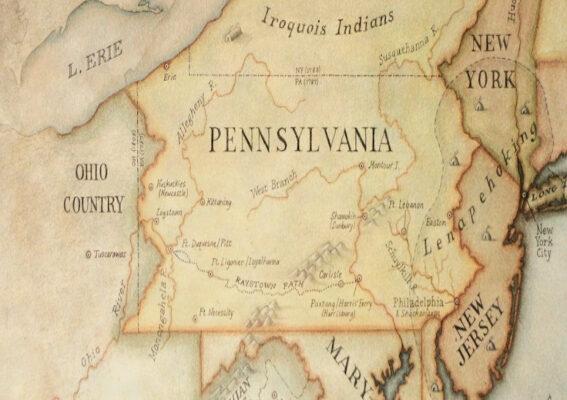In the book American Nations by Colin Woodard, he argues that “North America” has 11 distinct cultural nations. I would generally agree with this assertion. Unfortunately, Woodard is a Yankee, and his bias shows throughout the book. I’ve come to the conclusion that the book is a solid read for those opposed to the “one American nation” theory. As a Southern Nationalist, I can see American Nations providing Southerners with a solid blueprint on how to view the rest of the country. In this article, I’ll be addressing and adding to the argument regarding the existence of the “Midlander” nation.
The Midlands, argued by Collins, is a nation founded by the Pennsylvania “Dutch” (Germans) and Quakers in the 1600s. The region is to the south of Yankeedom and New Netherlands, but north of Appalachia and Tidewater. In many ways, the Midlands is one that is often in conflict with the others but also the adjudicator in many of the political contests between the main nations on the East Coast. The Midlands also sprouted from Pennsylvania; the state renowned for being a swing state. It should be remembered that the United States’ capital once sat in Philadelphia, largely as a compromise between the Northern and Southern colonies. While today the city’s nickname is an ironic joke, it once was the motto for the Midlander nation, “brotherly love.” Nonetheless, the capital’s presence there was an early foreshadowing of its position as a swing state.
In the early decades of the Union, the Midlanders and the South had a relatively strong relationship. Regional divides, while present, had not grown as challenging as they would later. In this time, Midlanders were largely just a strong section across Pennsylvania, northern Delaware and southern New Jersey. During these early days, they would quickly rally behind the Democratic-Republicans under the leadership of Virginia Tidewater statesmen. Pennsylvania voted for the winner of the majority of presidential races with the exceptions of 1804 and 1824. Thus, early in this era, the South had a solid relationship with the region which helped cement the rule of Jeffersonianism and then Jacksonianism in the Union.
Dixie’s troublesome history with this region began in the 1840s, when the Midlands became the first of the American nations to fully reject slavery. In turn, the Midlands started becoming politically and culturally averse towards the South and, eventually, the Southern people. The Quakers, especially, were given to abolitionist sentiments, which put them at odds with Dixie. However, for the most part, the Midlands were nowhere as vindictive and antagonistic as the New England Yankees. This would change with the 1860 election, when the Midlanders sided with the Republicans (a purely regional party). Lincoln would carry Pennsylvania with 56% of the vote. While not as hardline Republican as the New England Yankees, Midlanders came to detest secession, considering it treason, and thus transformed into enemies of the Southern people during our war for independence.
Nonetheless, a sizable number of the Midlander people would come to reconsider the actual cost “of saving the Union” with the massive amount of bloodshed by the Lincoln regime. Due to this, a strong peace movement developed in the North, particularly when Southern armies scored victories during 1861 and 1862. Eventually, this would cause New Netherlands, the Midlands and Northern Appalachia to re-evaluate their war on Dixie. By 1864, these nations would unite under a Philadelphian, General George B. McClellan. In many ways, Lee’s invasion into Pennsylvania in 1863 was an effort not just to win international support but also bring the impact of the war directly to the uncertain Pennsylvanian Midlanders. The offensive, of course, sadly failed, but nonetheless caused a momentary hesitation. In 1863, bodies lining the roads of Gettysburg would bring the horror of war directly to the Keystone State.
By early 1864, the war to “save the Union” had caused the deaths of thousands of young men from the North and the war itself seemed to be in a brutal stalemate. War morale in the Union seemed to drop, causing even the tyrant Lincoln to believe he would lose re-election. With this, Northern Democrats, many noted as “Copperheads,” would nominate General McClellan for president, as well as anti-war Borderlander George H. Pendleton of southern Ohio for vice president. They campaigned for peace and advocated for negotiations with the Confederacy. In many ways, the 1864 election was the truly most decisive one in American history – had McClellan won, it’s likely that the Confederacy would have negotiated a peaceful settlement. However, as everyone knows, events did not unfortunately unfold that way.
With the fall of Atlanta, Sherman was able to save Lincoln’s re-election. It also helped that Lincoln had created several new states by this point, like Nevada and “West Virginia.” On top of this, Union soldiers in Missouri, Maryland, Tennessee, and Louisiana were all able to vote and keep potential Southern Democrats away from the polls. By November, a majority of Midlanders flipped back to their former war mongering ways to finish off the South; ironically, only New Netherland (greater New York City and northern New Jersey) stood by McClellan’s peace hopes. The only states McClellan carried would be his then-home state of New Jersey, Delaware and Kentucky (a Southern borderland state). He also came relatively close (1% margin) in winning New York thanks to Democrat New Netherlands. With McClellan’s defeat, the tyrant’s boot finally crushed the outmanned and outgunned Confederacy in 1865.
In the decades after the defeat of the South, the Midlanders would largely find themselves in unison with Yankeedom on how to govern the “redeemed” Union. The (forced) United States truly grew corrupt during these decades, morphing into the Yankee Empire with massive corporate overlords. In the first election post-Reconstruction, Pennsylvanian Midlander Winfield Scott Hancock represented a weakened Democratic Party against the Republicans. General Hancock had famously sided with President Johnson for a more lenient version of Reconstruction, which caused Hancock to lose his command of the 5th Military District (Texas and Louisiana). In many ways, he was a solid picture of the Midlander in their more “moderate” ways, which often found them in opposition to the tyrannical measures of the fanatical Yankee Republicans during Reconstruction. From Reconstruction until 1916 (Woodrow Wilson being the interesting exception) not a single Democratic Party nominee for president was from the South, despite the South being a major faction in the party. However, Midlanders would continue to hold national power, and this was particularly true in the 1950s.
Following the collapse of the New Deal coalition in the late 1940s, the Republican Party would finally take back power with the 1952 election. In this, a supposed “Southerner,” who was born in Texas, which helped him win the state that year, and in 1956, wasn’t actually a Southerner. In truth, by blood, mindset, and raising, Dwight D. Eisenhower was a Midlander. To begin, Eisenhower’s family was from central Kansas, with their ancestry traced back to the Pennsylvania colony and then to Germany. He was raised and considered his hometown to be Abilene, Kansas. Eisenhower was known for being politically non-involved for most of his life as an army officer. Despite being friends, he would actively clash professionally with Patton, especially near the end of the fiery Southerner’s career. When he finally became president, he would have a warm relationship with the South due to the recent betrayal by President Truman and the false belief in his Dixian identity. Indeed, many Southerners viewed Eisenhower as a likely ally due to his more conservative nature, military experience, and background. At first, Eisenhower was and would do very little to aid Yankee politicians in ending segregation and home rule in Dixie. When Brown v. Board came in 1954, Ike only timidly embraced it, it seemed to many that he was a solid ally of the South. A prime example of Ike being seen as a moderate is when Texas Governor Allan Shivers blocked integration in 1956 with the Texas Rangers. Ike refused to step in, and was often attacked by Yankee leftist at the time. This seeming indifference and personal assistance played a part in Ike once again winning Texas that year, along with breaking Louisiana off from the Solid South.
However, in 1957, this cozy relationship would end and become clear during the standoff in Little Rock, Arkansas. After seeing the actions of Shivers the year prior, Arkansas Governor Orval Faubus was inspired and pushed by Southern voters to stop integration in their beautiful capital city. Faubus decided to send in the Arkansas National Guard to block integration and keep the peace. Ike, at first, was hesitant to step in until the media began sending television recordings of (rightfully) angry Arkansans opposing black students from breaking into their schools. Ike and many “moderates” in the Midlands fell over themselves and felt “opposition had gone too far.” They ignored the fact that the Supreme Court had violated its role in Brown v. Board. Despite being a supposed conservative, Ike in a move all too familiar to modern Southern voters condemned and betrayed the South.
Eisenhower was moved by his wishy-washy emotions and blind obedience in “law and order” much in the same way modern Republicans fell over themselves in the aftermath of Jan 6th to condemn their own voters for rejecting a stolen election. Ike sent in federal boots with the 101st Airborne Division to occupy Little Rock. He would air a speech demanding Southerners fall in line with “law and judges.” During the occupation of Little Rock, the federal troopers would beat and roughhouse local Southerners opposing the hostile takeover of their education system. Southerners, at the time, would cover photos of conflict, which were often hidden by the national press at time, and would lose trust in the Republican Party, as well as Eisenhower.
In the aftermath of this, Dixie would split in the 1960 election, with Louisiana and Texas flipping away from the Republican Party by voting for Nixon. The states of Alabama and Mississippi would vote for Virginia Senator Harry F. Byrd, rejecting the two-party option.
To get back to the point, it should be clear to any Southern Nationalist that Midlanders are incompatible with the South. Their track record shows them to be fair weather friends at best, and enemies at worst. Our modern times reflect this, with Pennsylvanians bolting to vote for Biden in 2020, thus bringing in the immigration crisis, inflation, and the theft of millions of dollars to Ukraine. Dixie united with them in 2016 to stop Hillary, only to have them flip flop to Joe Biden. To make matters worse, these people (Midlanders in Pennsylvania) elected a Democratic governor and senator (the one who wears a hoodie to Congress) in 2022. While many will claim these elections were stolen, as someone who has studied this state and its people, it seems clear to me that the Midlanders of Pennsylvania view Republicans as too “extreme.”
All polls at the moment have Pennsylvania as the closest swing state, with some occasionally having Biden still barely winning. I, for one, would no longer like to see my national elections decided by this nation of undecided “moderates.” Southern Nationalists: be ready for Pennsylvania, the main state of the Midlanders, to disappoint the MAGA movement in November when they decide Trump is “too radical and dangerous.” It is my hope that, after that, the Southern people will see that we need to cut all political ties with such milquetoast folks.
Dixie is better off without having the Midlands decide our fate.
-By Dixie Anon

O I’m a good old rebel, now that’s just what I am. For this “fair land of freedom” I do not care at all. I’m glad I fit against it, I only wish we’d won, And I don’t want no pardon for anything I done.






Very interesting article Dixie Anon … though perhaps somewhat irrelevant in the face of the fact that voting for elected sellouts is irrelevant everywhere in the Western democracies today. I think it was James Carville (of all people) who made a very salient observation about the respective demographics of Pennsylvania and Pennsyltucky, respectively: “Pennsylvania is Philadelphia at one end, Pittsburgh at the other end, and Mississippi in between.”
Say what you want about Midlanders? We have large Amish populations for a reason! Good luck when the power grid goes down!
Win!
Pennsylvania did not vote for Obiden in 2020. That state was totally faked up with fraudulent ballots counted in that selection. They may not have been with the South, but I am not convinced they were not on the right side that year.
Gentlemen’s Club here!
Win!